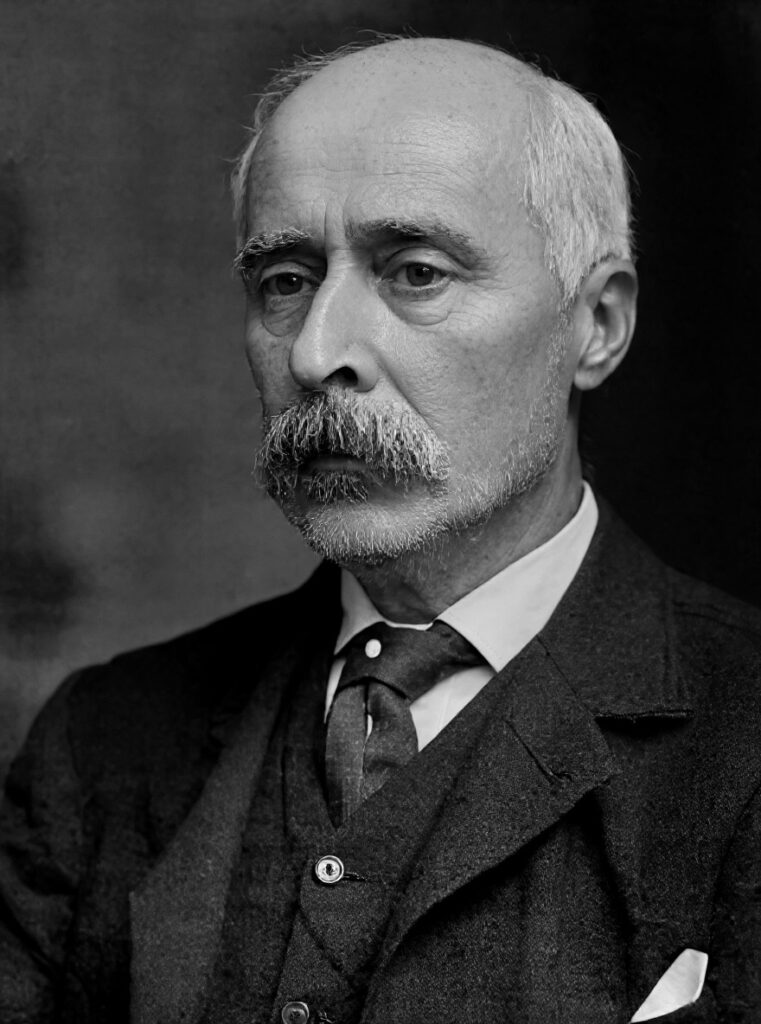Robert Marcus Gunn

Robert Marcus Gunn (1850-1909) was a Scottish Ophthalmologist.
Marcus Gunn was a pioneering figure in the clinical application of ophthalmoscopy. He is eponymously associated with several important fundoscopic signs, including Gunn’s dots, Gunn’s sign, and Gunn’s pupil, each of which continues to serve as key diagnostic markers in modern ophthalmology.
A highly skilled ophthalmoscopist, Gunn advanced the study of retinal pathology and the optic nerve at a time when the clinical utility of ophthalmoscopy was still evolving. He was also instrumental in establishing systematic teaching of ophthalmoscopy at Moorfields Eye Hospital in London, where he served as Senior Surgeon at the time of his death. Gunn combined a passion for clinical observation with an exceptional ability to communicate visual findings, influencing generations of ophthalmologists through both his teaching and publications.
Gunn’s clinical insights extended beyond the eye; he was among the first to describe the ophthalmoscopic evidence of retinal arterial sclerosis as a reflection of systemic vascular disease — a concept now central to understanding hypertensive retinopathy and cerebrovascular risk. His lifelong interest in comparative anatomy, neuro-ophthalmology, and pathology led to a wide-ranging body of published work. Gunn’s reputation as an astute and rigorous observer was recognised internationally, and his contributions continue to underpin contemporary retinal and neuro-ophthalmic examination.
Beyond medicine, Gunn was an avid naturalist with interests in botany, marine zoology, and geology. He spent much of his leisure time collecting fossils, ultimately donating his significant collection to the British Museum. Admired for his intellectual integrity, modest character, and clinical brilliance, Robert Marcus Gunn remains one of the most influential ophthalmologists of the late 19th and early 20th centuries.
Biography
- 1850 – Born at Culgower (also cited as Dunnet), Sutherlandshire, Scotland; youngest of four children. Attended village school and Golspie school; at age 14 moved to Edinburgh for professional training.
- 1871 – Graduated MA, University of Edinburgh.
- 1873 – Graduated MB CM, University of Edinburgh; MRCS; introduced to John Couper and began attending Moorfields Eye Hospital, London. Conducted comparative anatomical studies of the eye under Sir Edward Albert Sharpey-Schafer (1850-1935) at University College London.
- 1874 – Resident at Perth District Asylum, Murthly; performed ophthalmoscopic examinations of psychiatric patients.; studied in Vienna under Eduard Jäger von Jaxtthal (1818–1884)
- Austrian ophthalmologist (Dec 1874 – June 1875).
- 1875 – returned to London; resumed work under John Couper at Moorfields.
- 1876 – Appointed Junior House Surgeon, Moorfields Eye Hospital; promoted to Senior House Surgeon, Moorfields Eye Hospital.
- 1879 – Travelled to Australia to collect marsupial and monotreme eye specimens.
- 1880 – Appointed Ophthalmic Surgeon to National Hospital for the Paralysed and Epileptic, Queen Square; and Hospital for Sick Children, Great Ormond Street.
- 1882 – Awarded FRCS.
- 1883 – Elected Assistant Surgeon, Moorfields Eye Hospital.
- 1888 – Promoted to Full Surgeon, Moorfields Eye Hospital; delivered Arris and Gale Lectures
- 1898 – Vice-President, Section of Ophthalmology, British Medical Association, Edinburgh Meeting.
- 1900 – Delivered Bowman Lecture Visual Sensation.
- 1902 – Published on Keratitis Nodosa.
- 1906 – President, Section of Ophthalmology, British Medical Association, Toronto Meeting; addressed American Academy of Ophthalmology and Otolaryngology on Certain Affections of the Optic Nerve.
- 1907 – Elected President, Ophthalmological Society of the United Kingdom; published Family Optic Atrophy.
- 1908 – Delivered Presidential Address History of the Ophthalmological Society.
- November 29, 1909 – Died at Hindhead, Surrey, after a long illness; survived by his widow and two daughters.
Medical Eponyms
Marcus Gunn pupillary phenomenon (1902)
[aka relative afferent pupillary defect or RAPD] A pupil that responds by constricting more to an indirect than to a direct light, seen with unilateral optic nerve or retinal disease
1902 First description by Robert Marcus Gunn
It is not sufficient to find that it (the pupil) contracts well or fairly well on exposure; the eye must also be kept under direct stimulation of light and the pupil watched as to whether or not it shows that secondary dilatation under continued exposure that is found associated with the amblyopia of retro-ocular neuritis. If the vision of one eye only is affected, it is important to compare the behaviour of the two pupils when stimulated directly or consensually. Thus, in partial affection of the right optic nerve the right pupil will show this secondary dilatation during continued exposure to direct stimulation, while the left pupil will show the same behaviour on consensual stimulation. On the other hand, on stimulation of the left eye both the right and left pupil will behave normally. I need not remind you of the importance of this observation, inasmuch as it not infrequently enables us to diagnose a retro-ocular neuritis in the absence of all ophthalmoscopic evidence.
R Marcus Gunn 1902:21:275
Gunn’s pupil / Gunn’s phenomenon – Relative afferent pupillary defect observed with alternating light test; associated with optic nerve dysfunction. (Publication origin unclear; attributed to clinical teaching and observation by Gunn, not linked to a single publication.)
Marin Amat syndrome (reverse Marcus Gunn syndrome)
Marcus Gunn phenomenon (Gunn jaw winking syndrome): congenital syndrome (autosomal dominant) present in 5% of neonates with congenital ptosis. Widening of the ptosis when the patient opens their jaw or chews – secondary to a pathological synkinesis between the pterygoids and elevator palpebrae.
Gunn’s dots: minute bright retinal dots, typically seen around the macula; believed to be nerve fibre layer abnormalities. First described in: Gunn RM. Peculiar Appearance in the Retina. Trans Ophthalmol Soc 1883; 3: 110.
Gunn’s sign – Tapering and banking of retinal veins at arteriovenous crossings; sign of hypertensive retinopathy (retinal signs of arterial sclerosis). Original description associated with Gunn RM. Retinal Arterial Sclerosis. Trans Ophthalmol Soc 1888; 12; 1898; 18; 24.
- Tendency to tortuosity of the arteries, especially the smaller vessels.
- Variation in the calibre of the vessels, especially sudden diminution for a short length passing again into normal size. The calibre is apparently sometimes narrowed by nodules in the vessel walls, imparting to the vessels a beaded appearance.
- Alteration of the normal light streak. This becomes very much brighter and very much more sharply defined.
- Indentation of veins, either by supra-pressure of the artery crossing above the vein, or infra-pressure from crossing below. When there is considerable indentation there is great obstruction followed by all the sequela of back pressure, viz., stasis, thrombosis, oedema, and haemorrhages into the surrounding tissues.
Major Publications
- Marcus Gunn R. Congenital ptosis with peculiar associated movements of the affected lid. Transactions of the Ophthalmological Societies of the United Kingdom. 1883; 3: 283-287. [Marcus Gunn phenomenon]
- Marcus Gunn R. Peculiar appearance in the retina in the vicinity of the optic disc occuring in several members of the same family. Transactions of the Ophthalmological Societies of the United Kingdom. 1883; 3: 110-113. [Gunn’s dots]
- Gunn RM. Functional or hysterical amblyopia. The Ophthalmic review 1902;21:271-80. [Marcus Gunn pupil]
- Gunn RM. On ophthalmoscopic evidence of general arterial disease. Transactions of the Ophthalmological Societies of the United Kingdom. 1887; 18: 356-381. [Gunn’s sign of retinal arterial sclerosis]
- Gunn RM. Minute Anatomy of the Retina. J Anat Physiol 1877; 11: 357.
- Gunn RM. Continuous Electrical Current as a Therapeutic Agent in Atrophy of Optic Nerve and in Retinitis Pigmentosa. Roy Lond Ophth Hosp Rep 1882; 10: 181.
- Gunn RM. Peculiar Appearance in the Retina (Gunn’s Dots). Trans Ophthalmol Soc 1883; 3: 110.
- Gunn RM. The Eye of Ornithorhyncus. J Anat Physiol 1884; 18: 401.
- Gunn RM. Amblyopia from Bisulphide of Carbon. Trans Ophthalmol Soc 1886; 6: 372.
- Gunn RM. Nystagmus. Toxic Amblyopia. Trans Ophthalmol Soc 1887; 7: 305.
- Gunn RM. Retinal Reflexes. Roy Lond Ophth Hosp Rep 1887; 11: 348.
- Gunn RM. Growth of Lens Fibres. Foveal Reflex in Myopia. Trans Ophthalmol Soc 1888; 8: 126.
- Gunn RM. Retinal Arterial Sclerosis. Trans Ophthalmol Soc 1888; 12; 1898; 18; later 24.
- Gunn RM. Pemphigus of Conjunctiva. Trans Ophthalmol Soc 1893; 13: 30; 1895; 15: 68; 1896; 16: 45.
- Gunn RM. Haemorrhage into Optic Sheath. Trans Ophthalmol Soc 1896; 16: 95.
- Gunn RM. Bowman Lecture on Visual Sensation. Trans Ophthalmol Soc 1900; 20: 11.
- Gunn RM. Keratitis Nodosa. Trans Ophthalmol Soc 1902; 22: 97; and 29.
- Gunn RM. Family Optic Atrophy. Trans Ophthalmol Soc 1907; 27: 221.
- Gunn RM. Two Lectures on Congenital Malformations of the Eye. Ophthalmic Rev 1889; 8: 193.
- Gunn RM. Haemorrhagic Disease of Retina with Obliteration of Veins. Helmholtz Festschrift 1893.
- Gunn RM. Diseases of the Eye. In: Treves F, Manual of Surgery.
- Gunn RM. The Eyeball and its Surroundings. In: Morris’ Treatise on Human Anatomy.
- Gunn RM. Optic Nerve and Retina. In: Encyclopaedia Medica.
- Gunn RM. Sympathetic Inflammation of Eyeball. London: 1887.
References
Biography
- In Memoriam: Robert Marcus Gunn. Br Med J. 1909 Dec 11; 2(2554): 1719–1721
- In Memoriam: Robert Marcus Gunn. Lancet 1909; ii: 1786
- Biography: Gunn, Robert Marcus (1850 – 1909). Plarr’s Lives of the Fellows Online. Royal College of Surgeons of England.
- Beighton G, Wiedemann HR. The Person Behind the Syndrome. Springer. 1997: 74-76
Eponymous terms
- Marin Amat M. Sur le syndrome ou phenomen de Marcus Gunn. Annales d’oculistique, Paris, 1919, 156: 513-528.
- Bardsley PC. The Retinal Signs of Arteriosclerosis compared with those due simply to Increased Blood-pressure. Proc R Soc Med. 1917; 10(Sect Ophthalmol): 34–42.
Eponym
the person behind the name
Josh Taylor, MD University of Western Australia. Medical training in Western Australia with a keen interest in Ophthalmology.

